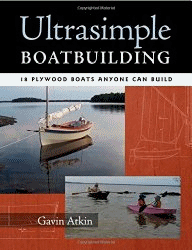Didi 950 in Australia

Fred Grimminck in Queensland, Australia, has previously built a boat to our
Didi Mini design. Now he is building a
Didi 950. In contrast to the boat of Mike Vermeersch that I showed yesterday, Fred is building his boat from scratch, marking and cutting the plywood panels himself from our drawings.
Today I have received photos from Fred of his project. He is at the same stage as Mike but the different perspective of his photos shows the details from different angles to help visualise how it all goes together. Click on the photos to enlarge.
 |
| Bottom panels fitted, bow view |
In this photo you can see how the bottom panels are slightly Veed aft but the V increases toward the bow and the flat panels become very fine, both features to soften the ride when the boat is planing fast in lumpy water and slamming over short waves can become uncomfortable. The edges of the panels land on the doublers of the tangent stringers at the intersections of flat and radiused skin panels. The edges are rebated to half-thickness, with the first layer of radius plywood landing on the doubler and the second layer landing on the rebate, forming a Z-shape joint detail.
 |
| Ready for side panels to start |
In the photo above, the doubler at the upper tangent is in place and part of the lower side panel is clamped in place, seen at bottom right. The left edge of this panel has been planed to form the sloping surface for the scarph joint to the next piece, the main difference from the jigsaw joints of Mike's kit. Also visible in this photo, are scarph joints in some of the stringers. These appear to have been glued in place on the hull. The alternative is to pre-glue them into long lengths before installing in the boat.
 |
| Interior view of transom and cockpit area |
The photo above shows some of the interior detail. The transom is 9mm plywood but has doublers to strengthen it around the perimeter, at the backbone and at the rudder hardware. You can see the plywood backbone passing through the bulkhead ahead of the transom. These intersections are self-locating egg-crate detailing to assist with accuracy during setting up the skeleton. The backbone is on centreline in bow and stern but changes to a pair of backbones offset from centreline from forward of the mast through to the cockpit.
A major difference between the two boats of Mike and Fred is in the keel detailing. Mikes boat has a fixed bulb keel that hangs from an internal support box that is bolted between the two components of the double backbone. The support box also holds the engine beds and bearers, sited directly over the keel. Fred's boat will have a lifting keel. It will be housed in a modified keel support box of identical footprint but with integrated casing for the lifting keel and without the engine beds. Fred's engine will be a saildrive unit located under the companionway and front of the cockpit.
There are also boats to the
Didi 950 design beign built in Greece and Latvia. Watch this blog for news on all of them.
Go to
http://dixdesign.com/ to see our full range of designs.

 Fred Grimminck in Queensland, Australia, has previously built a boat to our Didi Mini design. Now he is building a Didi 950. In contrast to the boat of Mike Vermeersch that I showed yesterday, Fred is building his boat from scratch, marking and cutting the plywood panels himself from our drawings.
Fred Grimminck in Queensland, Australia, has previously built a boat to our Didi Mini design. Now he is building a Didi 950. In contrast to the boat of Mike Vermeersch that I showed yesterday, Fred is building his boat from scratch, marking and cutting the plywood panels himself from our drawings.


Walang komento:
Mag-post ng isang Komento